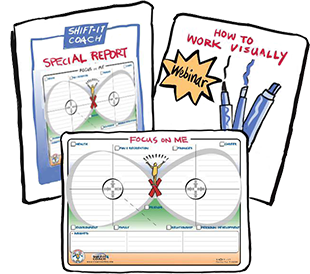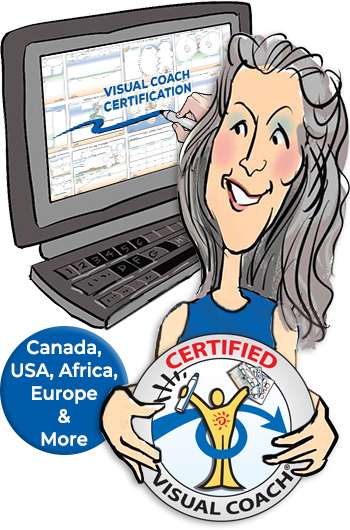Interactive-Graphics is a wonderful way to work – whether in a group or individual setting. I’ve been in the overall field for 17 years now – and have worked in all of the four main genres: custom chart work, graphic recording, graphic facilitation and graphic coaching.
As the field continues to expand and generate more and more interest, I find it’s helpful for people new to the field (either as clients or new practitioners) to understand the four main applications of working visually and how they are related … and also profoundly different.
THE WONDERFUL WORLD OF INTERACTIVE-GRAPHICS:
Below is a large wall mural that I use in my Fundamentals of Interactive-Graphics workshop to introduce the four main applications of the work and their distinctions, particularly the level of ‘interactivity’ between them – ranging from very passive or ‘push’ type uses to very interactive or ‘pull’ type uses.

Wonderful World of Interactive-Graphics Chart (four main definitions).
Click image to view on Flickr:
1. CUSTOM CHART WORK
The most static or passive type of work is what I call ‘custom chart work’. Custom charts are the various visual materials one can create ahead to time to convey information to a group or audience. Custom charts can vary from very practical and easy pieces, like welcome posters, models, or agenda charts (like the one below from an old workshop of mine) — to much more elaborate ‘information architecture’ pieces that takes days/weeks/months to complete and deep corporate pockets to commission. See Grove Consultants, XPLANE and Bonfire Communications for companies who play in that space. Generally, custom charts are used to gather and push agreed upon information to viewers (there is usually little interaction or co-creation unless facilitation or interactivity is somehow built into the process to prepare them or to gather pushback or feedback afterwards).

Example of Custom Chart Work (Workshop Agenda)
2. GRAPHIC RECORDING OR VISUAL MEETING NOTES
Moving up the interactivity scale, we proceed into the area of ‘graphic recording’. Produced by ‘graphic recorders’ these large, wall-size documents are created live during gatherings and meeting venues – usually the Recorder is silently doing her best to ‘cut’ or ‘cull’ what is being spoken about into an attractive (and hopefully rationally useful) visual summary. This method is best used when the topic is a general and easily tracked nature (graphic recording is not good for highly detailed situations).
Graphic recordings are usually produced to the side or back of a room, off from where the main action is taking place. Having done this kind of work for many years earlier in my career, I am at liberty to call them a ‘bit of a party trick”. Entertaining, fun to produce, and adding spice to an event — they can operate as novel takeaways for event participants and conveners.

Example of Graphic Recording
Above is an example of graphic recording work, done for a women’s funding conference — it’s the highlights of a talk on branding.
3. GRAPHIC FACILITATION
Next we move into the area of Graphic Facilitation – in my mind the most useful genre for group work. Graphic Facilitation can either be provided by a true Graphic Facilitator (someone who both contracts for and facilitates a client engagement AND takes the visual notes at the same time) or via a Graphic Facilitation team (provided by a lead facilitator and one, or several, Graphic Recorders).
Given the facilitative nature of the work, Graphic Facilitation has a more text-based and functional appearance than Graphic Recording and the charts are ‘co-created’ by the participants in conjunction with the facilitation team. It is by far the most interactive of the genres — with the charts being created in front of everyone’s eyes and through everyone’s words (sometimes through everyone’s markers when participants are invited to get in the mark marking as well!). Usually pre-constructed templates or large wall forms (like the Content map from Grove Consultants behind me in the picture below).

Christina Doing Demo of Graphic Facilitation Using Grove’s Context Map
Click to view this and other graphic facilitation photos on Flickr:
4. GRAPHIC COACHING
And, last but not least, we come to the specialty niche area of which I’m a pioneering practitioner and teacher – Graphic Coaching (the use of interactive-graphics in coaching and personal growth with individuals, couples and/or families). Graphic Coaching is interactive at its core (like graphic facilitation work) but instead of a group you are working with just one person or partners (or a few people if working with a family group).

Mentee Allison Doing Graphic Coaching with Her Workshop Partner
Click Here to View Other Graphic Coaching Photos:
Graphic coaching can be spontaneous recording of a person’s thoughts or it can be much more constructed – depending on the type of coach, therapist or counselor you are and the process you follow. After many years of doing group facilitation (primarily strategic planning and visioning) and coaching work (I am a CTI trained coach, hypnotherapist and energy worker) – I slowly created my own step-by-step process and suite of visual coaching tools … called The SHIFT-IT Graphic Coaching Process®. Through my SHIFT-IT Certification program I now empower other helping professionals from around the world to use SHIFT-IT with their own clientele.
ADD INTERACTIVE-GRAPHICS TO YOUR OWN TOOLKIT:
As you can see, the world of interactive-graphics is rich … and holds something of value for most process leaders — whether you are a consultant, trainer, facilitator, coach, therapist or manager. Interest in this field is growing in leaps and bounds and clients are increasing asking and aware of the benefits of working visually (greater clarity, more effective use of time and limited resources, reduced conflicts and tensions, etc).

I have extensive experience in all four genres of the work and have successfully trained professionals for over decade, from all walks of life and art abilities. You DO NOT have to be an artist to do this work– and if you are an artist, great! There is room for all to play in this effective, rational/emotional and client-pleasing methodology.
I have extensive experience in all four genres of the work and have successfully trained professionals for over decade, from all walks of life and art abilities. You DO NOT have to be an artist to do this work– and if you are an artist, great! There is room for all to play in this effective, rational/emotional and client-pleasing methodology.
For information on public and private trainings, including Graphic Coach Certification, see my Training and Workshops page.




Hello Christina, Pam Bourke and I are Brisbane consultants with a fair amount of our work in facilitation. We are keen to add basic graphic facilitation to our toolbox and are wondering if you have online courses early in 2012 for people at our level. We have OK facilitation frameworks but limited artistic ability at this point (and from our assessment of ourselves…we know everyone can draw but we haven’t had to do any serious drawing). Michelle Walker gave us a recommendation about your talents (thnx Michelle), Kind regards
Mary Maher, Pam Bourke
Hi Mary, thank you for your email and interest in the Fundamentals of Interactive-Graphics program.
The current online course is now mid way through. If you are interested in this program, you still have the option to sign up which will give you access to the audio recordings. presentation notes and Ning forum of the sessions that have taken place – which will get you caught up to where the class is now. Plus we’ll send you via express shipping the extensive handbook and DVDs that all students are using.
You can access the registration page here for more information. The next FIG online course will be held next fall of 2012. Christina offers the online program in the fall, the in-person in spring … and also hosts private custom trainings in Victoria, BC, Canada for those who want to travel for specialized attention.
Thank you, Jessica Turvey
Customer Care
SHIFT-IT Coach, Inc.